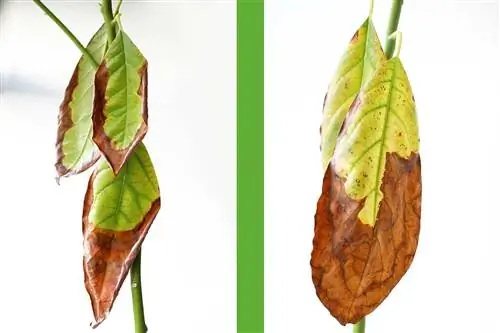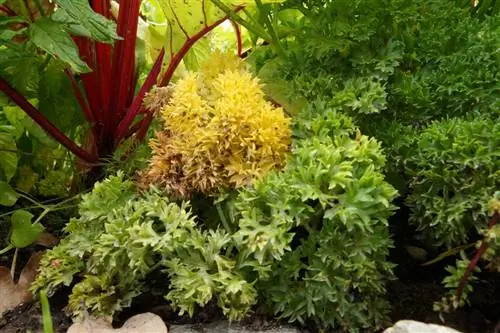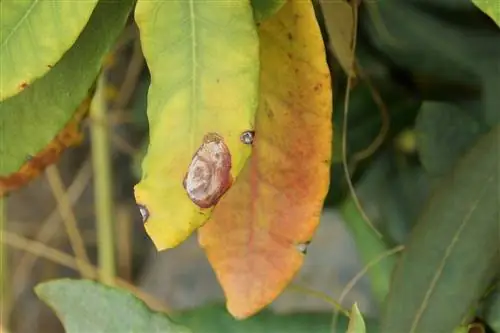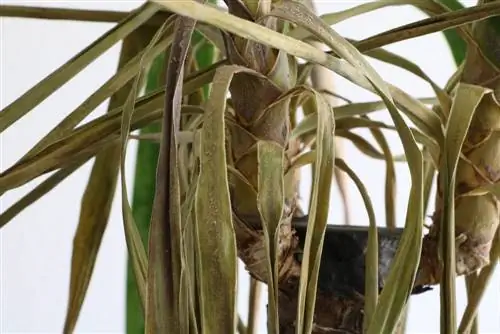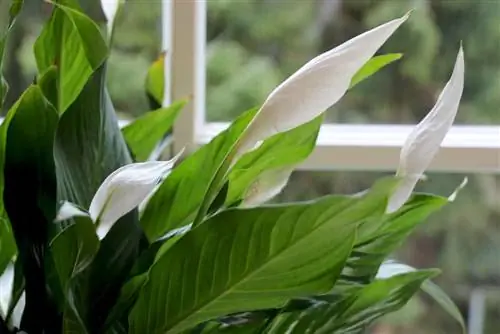- Author admin [email protected].
- Public 2023-12-17 03:39.
- Last modified 2025-01-24 12:45.
Thuja brabant is a very resistant, robust plant. Diseases and parasites rarely occur. However, care errors can cause serious damage to the tree of life. From the wrong location to over-fertilization, unfavorable care conditions can cause discoloration. The good thing about it is that errors in care are relatively easy to prevent and can often be remedied with little effort.
Thuja brabant
Thuja brabant - also known colloquially as the tree of life - is a very robust and resistant plant that is often used for planting hedges. Diseases and parasites usually only appear on the plant if there are errors in care.
Causes
The causes of discoloration can be varied. They include, among others:
- wrong location
- too much sunlight
- wrong substrate
- too dry
- Waterlogging
- Overfertilization
Pests and diseases can of course also be responsible for the yellow or brown discoloration, but experience shows that they are simply the consequences of incorrect care conditions.
Location
The optimal location for Thuja brabant is partially shaded to sunny. In semi-shady or shady locations, the arborvitae grows more loosely and therefore offers less privacy. However, if the plants are continuously and unprotected exposed to the blazing midday sun, burns can occur. The typical result is yellow to brownish discoloration. These burns are even more common if the tree of life has been cut during strong sunlight. The cut surfaces not only burn more easily, but also dry out very quickly.
drought

Drought or lack of water can have a significant impact on the plant. Dryness can quickly lead to damage, especially in very bright locations and permeable soil, but also in very young arborvitae that have not yet had enough time to grow. What is typical here is that the shoots show brownish discoloration from the outside to the inside. Extensive watering when necessary, for example in persistently dry phases or during growth, can help. Sections that have already dried out and died cannot be saved, but progressive changes and discoloration can be avoided.
Waterlogging
Consistent wetness or waterlogging can cause root rot, discoloration and damage. This also weakens the tree of life, which can promote infestation with pathogens and parasites. When choosing the location, care should therefore be taken to ensure that the planting area is not susceptible to waterlogging. Depressions and areas near a garden pond are therefore extremely unsuitable. When watering, care should also be taken to ensure that the watering is not too generous and that the water can drain off easily.
Overfertilization
The tree of life is very frugal when it comes to nutrient supply. This can lead to over-fertilization comparatively quickly. Mineral fertilizers should also be avoided, as Thuja Brabant is very sensitive to s alts. However, mulch and organic fertilizers, such as well-rotted compost, are suitable. Conifer fertilizer that is specifically tailored to your needs is ideal. However, these should only be administered if growth is very weak and the substrate is poor in nutrients. Even then, a single application of fertilizer per year is usually sufficient.
Substrate
Slightly acidic, moist to swampy soil is well suited for Thuja brabant. However, it is important to maintain balance here. Drought is not good for the plants, but neither is waterlogging. The water should therefore be able to drain away without any problems. The substrate should also be able to store moisture. If the soil is dry, a layer of mulch or gravel can help prevent it from drying out as quickly. If the substrate is very moist, a drainage layer can prevent waterlogging and thus root rot.
Root rot
Root rot occurs when the roots are constantly exposed to waterlogging or excessive moisture. The drainage layer already mentioned can help here. For drainage, potsherds, gravel or sand are placed in the planting hole before the tree of life is inserted. This layer ensures that the water can drain away better and the roots are protected from waterlogging. If root rot has already occurred, the tree of life can still be saved. However, it is important to recognize the disease early.
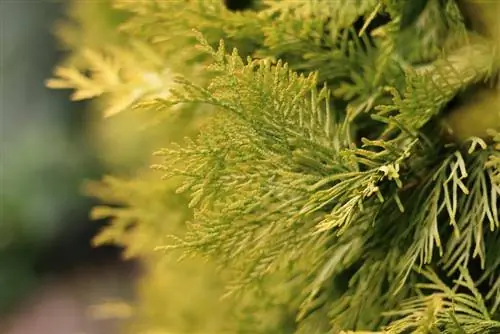
She expresses herself through:
- weakened growth
- first yellow discoloration, then brown discoloration
- gradual death of roots and plant
If all care errors apart from waterlogging can be ruled out, root rot is a comparatively likely disease. The affected plants can be saved if the following steps are followed:
- Carefully dig up Thuja Brabant and rinse the soil from the root ball.
- Cut off damaged root areas with sharp scissors.
- Allow the root ball to air dry for a few hours.
- Change the soil in the area of the planting hole and, to be on the safe side, treat it with an appropriate fungicide.
- Introduce a drainage layer and reinsert the tree of life.
Even after this measure, there is no guarantee that the plant will survive. However, there is a possibility of rescue.
Parasites and diseases
Thuja brabant is inherently resistant to parasites and diseases. Problems usually only arise if there were previous care errors and the plant was weakened as a result. Root rot and other fungal diseases are the most common. Appropriate fungicides can be used against this.
Age
Thuja brabant becomes bald from the inside out over time. Sections that are discolored brown can therefore also be due to age or incorrect blending. A regular blend right from the start can be helpful. Care should be taken not to cut into the old wood.
When you cut into old wood, brown or bare spots or gaps are left behind.


